
Delta Trianguli Australis is a single, yellow-hued star in the constellation Triangulum Australe. It is approximately 606 light years from Earth.

Psi Virginis is a suspected binary star system in the zodiac constellation of Virgo. It can be seen with the naked eye and has an apparent visual magnitude of +4.80. Based upon the annual parallax shift of 5.99 milliarcseconds, the distance to this star is roughly 540 light years. The angular size of Psi Virginis was measured on December 26, 1975 during an occultation by the Moon, yielding the estimate 6.5±0.3 milliarcsec.

Sigma Virginis is a star in the zodiac constellation of Virgo. It can be faintly seen with the naked eye with a baseline apparent visual magnitude of 4.86. Based upon parallax measurements, the distance to this star is roughly 680 light-years.

Omega Virginis is a solitary star in the zodiac constellation Virgo. It has an apparent visual magnitude of +5.22, which is bright enough to be faintly visible to the naked eye. Based upon an annual stellar parallax shift of 6.56 milliarcseconds, it is located about 500 light years from the Sun.

Theta Apodis is the Bayer designation for a star in the southern circumpolar constellation of Apus. It is a variable star with an apparent visual magnitude range of 4.65 to 6.20, which, according to the Bortle Dark-Sky Scale, means it is a faint star but visible to the naked eye from dark suburban skies. The distance to Theta Apodis is approximately 350 light-years, based upon parallax measurements made from the Gaia telescope. It is unusual in that it is a red star with a high proper motion.
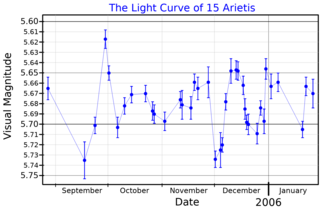
15 Arietis is a single variable star in the northern constellation of Aries. 15 Arietis is the Flamsteed designation; it also bears the variable star designation AV Arietis. It has an apparent visual magnitude of 5.74, which is just bright enough to be visible to the naked eye from dark suburban skies. An annual parallax shift of 5.84 mas corresponds to a physical distance of approximately 560 light-years from Earth. At that distance, the star's brightness is reduced by 0.33 in magnitude because of extinction from interstellar gas and dust.
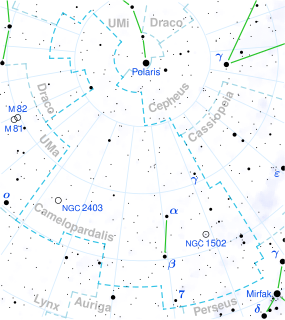
Beta Camelopardalis, Latinised from β Camelopardalis, is the brightest star in the northern constellation of Camelopardalis. It is bright enough to be faintly visible to the naked eye, having an apparent visual magnitude of 4.02. Based upon an annual parallax shift of 3.74 mas as seen from Earth, it is located roughly 870 light-years from the Sun. It is moving closer with a radial velocity of −190 km/s and is most likely a single star.
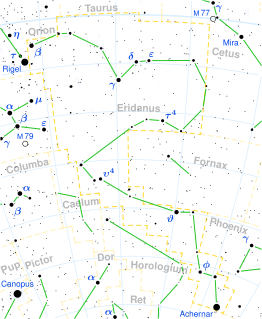
Tau4 Eridani is a binary star system in the constellation Eridanus. It is visible to the naked eye with an apparent visual magnitude of 3.65. The distance to this star can be estimated using the parallax method, which yields a value of roughly 300 light years.
NO Apodis is semi-regular pulsating star located in the far southern constellation Apus. It varies between magnitudes 5.71 and 5.95, its pulsations of periods 26.2 and 26.6 days respectively. Located around 780 ± 20 light-years distant, it shines with a luminosity approximately 2059 times that of the Sun and has a surface temperature of 3568 K.
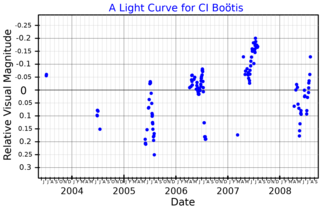
HD 126009 or CI Boötis is a variable star in the northern constellation of Boötes.
HD 30442 is an asymptotic giant branch star in the northern constellation of Camelopardalis.

Theta Pyxidis, Latinized from θ Pyxidis, is a red M-type giant in the constellation Pyxis. It is approximately 500 ± 30 light years from Earth. It is of spectral type M1III and semi-regular variable with two measured periods of 13 and 98.3 days, and an average visual magnitude of 4.71, It shines with a luminosity approximately 970 times that of the Sun and has a surface temperature of 3825 K. It has a diameter around 54 times that of the Sun.
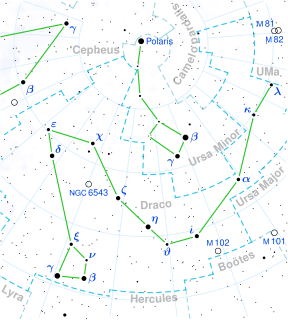
45 Draconis is a single star located in the northern circumpolar constellation of Draco, around 3,500 light years from the Earth. 45 Draconis is the Flamsteed designation, while it has the Bayer designation of d Draconis. This object is visible to the naked eye as a faint, yellow-white hued star with an apparent visual magnitude of 4.78. Radial velocity measurements indicate it is moving closer to the Sun at the rate of −12.5 km/s.
7 Ceti is a single, variable star in the equatorial constellation of Cetus. It has the variable star designation AE Ceti. The star is visible to the naked eye with a baseline apparent visual magnitude of 4.44. Based upon an annual parallax shift of only 7.3 mas, it is located roughly 450 light years away. It is moving closer to the Sun with a heliocentric radial velocity of −23 km/s. Eggen (1965) listed it as a probable member of the Wolf 630 group of co-moving stars.
Phi2 Hydrae, Latinized from φ2 Hydrae, is a star in the constellation Hydra. It originally received the Flamsteed designation of 1 Crateris before being placed in the Hydra constellation. Based upon an annual parallax shift of 4.31 mas as seen from Earth, it is located roughly 760 light years from the Sun. The star is faintly visible to the naked with an apparent visual magnitude of 6.09. It forms a triangle with the fainter φ1 Hydrae and the brighter φ3 Hydrae, between μ Hydrae and ν Hydrae.

Omicron1 Orionis is a binary star in the northeastern corner of the constellation Orion. It is visible to the naked eye with an apparent visual magnitude of 4.7. Based upon an annual parallax shift of 5.01±0.71 mas, it is located approximately 650 light years from the Sun. At that distance, the visual magnitude of the star is diminished by an interstellar absorption factor of 0.27 due to intervening dust.

9 Pegasi is a supergiant star in the constellation Pegasus. Its apparent magnitude is 4.35.

35 Cygni is a spectroscopic binary star in the constellation Cygnus. Its apparent magnitude is 5.18. Located around 1,000 parsecs (3,300 ly) distant, its primary is a yellow supergiant of spectral type F6Ib, a massive star that has used up its core hydrogen and is now fusing heavier elements.
AK Pyxidis is a semiregular variable star located in the constellation Pyxis. It varies between magnitudes 6.09 and 6.51, pulsating to multiple periods simultaneously of 55.5, 57.9, 86.7, 162.9 and 232.6 days. Located around 1228 light-years distant, it shines with a luminosity approximately 1500 times that of the Sun and has a surface temperature of 3410 K.
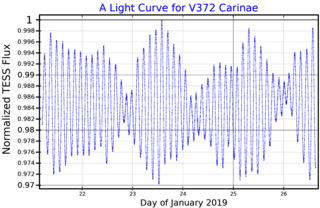
V372 Carinae is a single star in the southern constellation of Carina. Located around 1300 light-years distant. It shines with a luminosity approximately 1742 times that of the Sun and has a surface temperature of 14132 K. It is a Beta Cephei variable.












